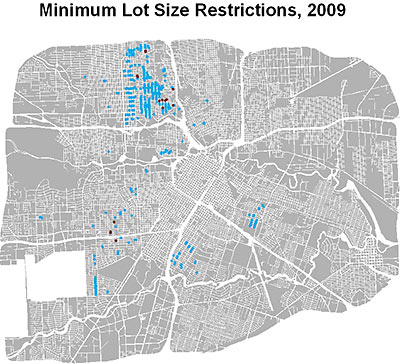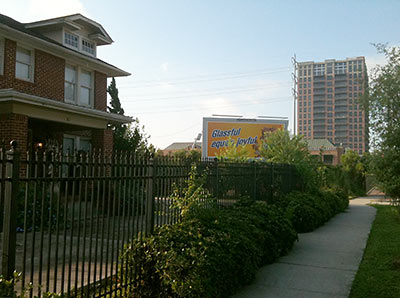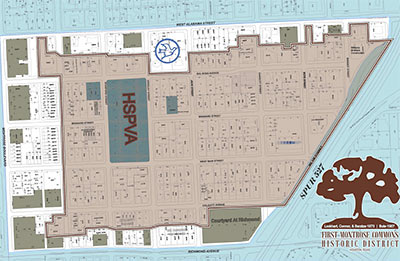BANDIT BILLBOARDS BANISHED By order of a U.S. district judge, 59 Houston-area billboards will be taken down over the next 12 months by the receiver in charge of the now-bankrupt company that erected them in violation of city ordinances. Approximately half of the billboards are between I-45 and 290 outside Beltway 8; none of them are on Highway 59. All were constructed recently outside Houston city limits but inside its “extraterritorial jurisdiction.” [Mayor’s Office; map (PDF); more detail from the Chronicle]
Tag: Development Restrictions
A small flurry of last-minute amendments — some of them apparently pushed at the request of builder and Realtor groups — means it may take a little time for everyone to sort out all the details of those changes to the preservation ordinance city council passed earlier today. But here are a few highlights, as we’ve pieced them together: Creating a new historic district will now require the approval of owners of 67 percent of all tracts in the district. Also, decisions by the archaeological and historical commission (the HAHC) will now have more teeth: Property owners whose plans for renovations, new construction, or demolition have been rejected will no longer be able simply to wait 90 days and proceed anyway. However, HAHC rulings can now be appealed to the planning commission, and if that doesn’t work, to city council as well.
But the ordinance’s most exciting feature is the one-time opportunity for all existing historic districts — except for the Old Sixth Ward and Main St./Market Square — to remove the shackles of . . . uh, history. All it’ll take to start the repeal process in one of those districts is signatures of owners of 10 percent of the tracts. (And once the city posts the new petitions, districts will have 30 days to gather them.) For each district where that threshold is reached, there’ll be public meetings and a vote — by mail-in ballot. If owners of 51 percent of the tracts in a district vote for repeal, the planning director will recommend to city council that that district’s historic designation be removed — or that the boundaries be shrunk and redrawn to maintain 67 percent support. For each district, city council will make a final decision.
- Previously on Swamplot: Preservation Ordinance Passes
PRESERVATION ORDINANCE PASSES Houston’s City Council has just voted to approve a new — amended — historic preservation ordinance. We’ll have more details shortly. “We know there are none of you out there that are absolutely happy,” said council member Sue Lovell after the vote. “That means we have a good ordinance.”
HISTORIC DISTRICTS VOTE: NEXT WEEK Yesterday’s scheduled city council vote on the latest version of revisions to Houston’s preservation ordinance was postponed for a week — but not before 7 council members offered their own separate amendments. Among them: a proposal by mayor pro tem Anne Clutterbuck that would allow historic districts to keep their current rules — or submit an application to be governed by the new stronger protections. But Mayor Parker doesn’t want a tiered system: “The mayor argued that leaving the ordinance unchanged would allow districts to be weakened ‘one house at a time,’ such as when owners legally could proceed with demolition even after their request to do so was denied. ‘We may lose some of the footprint of existing historic districts, but we’ll have an ordinance that actually protects them,’ she said.” [Houston Chronicle]
Note: Planning and development weighs in. See update below.
Tonight’s 6:30 meeting at the George R. Brown is the only public meeting scheduled to discuss the latest round of proposed changes to Houston’s preservation ordinance, dubbed the “final draft” in some documents. The planning department came out with this revised set of proposed amendments last week, but figuring out what’s in them isn’t so easy. The department hasn’t created any summaries of the new proposal — thought it did for the last round — and it hasn’t specified what’s different from the earlier proposed amendments either. Even more fun: The new amendments have only been released as image scans, making text searching — and what should be the simple task of comparing one set of amendments to the other — a not-so-simple task.
So what’s in the latest round of proposed changes? Swamplot outlined the new proposed method for existing historic districts to “reconsider” — and possibly shed — their historic designation last week. But since then, the department has only released a presentation given by the planning director. Working from that, here’s the best summary of the rest of the provisions we can piece together:
COMMENT OF THE DAY: MINIMUM LOT SIZE ORDINANCE EXIT STRATEGY “. . . The future of the minimum ordinances will depend on the individual blocks when the ordinances themselves expire. A few of my neighbors are planning for their retirement as soon as their ordinances expire with several options: duplexing their house with a garage apartment for rental income or selling out to condo builders as a last laugh for the looming McMansions next to them. If I don’t think my block will re-up our ordinances, I’ll be sure to sell out before the vultures start circling.” [Studes Second, commenting on Where Houston’s Lot-Size Restrictions Went, Year by Year]

Using data from Houston’s planning department, University of Maryland grad student Chris Dorney has put together a series of diagrams showing which blockfaces in the Inner Loop have restricted lot sizes — and when they’ve done it. His maps start in 2002, when the predecessor to the city’s current Minimum Lot Size ordinance first went into effect. The ordinance allows residents of a single side of a single block to restrict homeowners in that block from subdividing lots below a certain size; its cousin, the Minimum Building Line ordinance, does the same for front setbacks. Dorney explains:
Each [diagram] shows the Inner Loop and indicates blockfaces with special minimum lot size restrictions already in place (red dots) and new for the given year (blue dots) (i.e. blue dots turn red the following year). There are clear spatial patterns to the adoption of these ordinances which it would be interesting to know more about. Perhaps most interesting to people from zoned cities is why every block has not decided to enact such restrictions…a zoning ordinance would likely cover every block uniformly.
And here they are:
PAPERS, PLEASE? A Tomball city council member’s attempt to prohibit anyone unable to cough up government-issued documentation of citizenship or residence from owning any sort of property or business, or from renting a home within city limits was defeated last night by a vote of the entire council — along with a few other proposals intended to get area residents riled up about illegal immigration: “All of the controversial measures, which drew both strong support and heated opposition from citizens and activists Tuesday night, were proposed by first-term Tomball City Councilman Derek Townsend Sr. His move to place the items on Tuesday’s agenda was seconded by Councilman Mark Stoll, who said he did not support the proposals but wanted to give Townsend a venue for discussion. . . . Townsend told the audience his proposals were not about racism, but about standing up for the U.S. Constitution.” [Houston Chronicle]

 The art-gallery building at 4411 Montrose, just north of the bridge over the Southwest Freeway, stands only a few feet back from the front sidewalk. But just one block south, the Midway Companies is planning to plant its new 13-story office tower (which, like 4411 Montrose, will feature a restaurant space on the ground floor and gallery spaces upstairs) a full 25 feet back from the Montrose Blvd. property line. But that’s not because Midway is shy about getting any variances necessary to get around mandated city setbacks.
The art-gallery building at 4411 Montrose, just north of the bridge over the Southwest Freeway, stands only a few feet back from the front sidewalk. But just one block south, the Midway Companies is planning to plant its new 13-story office tower (which, like 4411 Montrose, will feature a restaurant space on the ground floor and gallery spaces upstairs) a full 25 feet back from the Montrose Blvd. property line. But that’s not because Midway is shy about getting any variances necessary to get around mandated city setbacks.
No, Midway director Shon Link tells Swamplot the M Fifty-Nine building must stand clear of the bright yellow Clear Channel billboard that pokes out from the southwest corner of the property. Restrictions require the billboard to have a clear view of oncoming traffic driving south on Montrose. Currently peeking out from the bottom part of the billboard: The Nesquick Bunny.
Behind Montrose, M Fifty-Nine won’t be so shy with the streets:
The mayor’s office is out with a “public comment draft” of proposed changes to Houston’s Historic Preservation Ordinance. The biggest (and most expected) change: There’ll be no more 90-day “compliance waivers” issued for historic-district properties. Under the previous ordinance, owners of contributing properties in historic districts whose plans for new construction, demolition, or renovation had been rejected by the city’s historic commission could proceed with those plans anyway after simply waiting 90 days. Under these changes, the Old Sixth Ward — labeled a “protected” historic district because the waivers weren’t allowed there — will now be the model for all others.
But the changes also include a completely revised process for neighborhoods to vote on historic-district status. Previously, for a neighborhood to file an historic-preservation application, it needed to submit a petition signed by owners representing more than 51 percent of its tracts. But the new system puts power into the hands of owners who are willing to express an opinion and takes it away from those who can’t be bothered or found. It allows an application to be filed if 67 percent of the property owners in a district who send in special cards distributed for that purpose indicate on those cards that they’re in favor of the designation.
There’s more. Here’s the city’s official summary of the changes:
MAKING THE TITLE INSURANCE PAY A Harris County district court has ordered Stewart Title Guaranty to pay $2.8 million to a Sugar Land developer after the title company failed to pay out on a title policy. Back in 2007, Ponderosa Land Development was hoping to build a Chase Bank branch at the corner of Settlers Way and Highway 6. AmeriPoint Title, the title company for the transaction, had obtained title insurance from Stewart Title to cover its work. But AmeriPoint’s title search failed to uncover a deed restriction on the property that specifically prohibited banks from being built on that site: “Stewart Title only offered to pay $200,000 of the $1.83 million title policy, arguing that the land was not worth that much. [Ponderosa’s James] Chang says the purchase price was dictated by the value of the property with the ground lease to JP Morgan and planned sale of the bank to an investor upon completion. Ponderosa is now free to sell the vacant property. Houston Suds has had a contract to buy the site for $953,000 since November 2008, but could not close the transaction and build a car wash until the legal matter was resolved.” [Houston Business Journal; previously on Swamplot]
HOUSTON’S HISTORIC HOLD As expected, city council approved yesterday what Mayor Parker called a “pause in the action” that would prevent until the end of the year all historic-district demolitions and new construction not specifically approved by the city historical commission. Previously, the city’s sharp-gummed preservation ordinance allowed property owners whose plans for historic-district properties had been rejected by the commission simply to wait 90 days before proceeding with their projects anyway. Mayor Parker says she hopes a revised permanent ordinance can be crafted and voted on by September. An amendment also passed by council provides a special exemption for property owners who have already spent money on new construction. The approved temporary changes will also prevent new applications for historic districts from being filed. But the timing worked out for Glenbrook Valley, the Woodland Heights, and Houston Heights South districts anyway — all three neighborhoods got their applications in under the wire. [HTV]

There’s more historic-district action on today’s city council agenda than the proposed temporary ban on gonna-do-it-anyway waivers: Council members are expected to approve First Montrose Commons as Houston’s 16th historic district. The planning commission approved the new district more than a month ago. If the council also votes today to put in place a temporary moratorium on the designation of new historic districts, First Montrose Commons will have gotten in just under the wire.
When last we left the east Montrose hood — bounded roughly by West Alabama, Richmond, Montrose Blvd. and the Downtown spur — its quest for historic-district status had been stumped by HSPVA, which counts for a large chunk of the proposed district. HISD’s decision on the petition, wrote neighborhood-association president Jason Ginsburg at the time, would either “make or break” the district. So what happened?
WHY YOU MIGHT WANT TO SIGN THAT CONSTRUCTION CONTRACT BY WEDNESDAY Still trying to decide if you should go ahead with that historic district new-construction project you’ve been considering? Here’s some info that might help you decide to get on with it: If you sign and at least partially pay for a contract with an architect or builder before the proposed temporary ban on historic-district end-arounds passes city council (which might happen as early as Wednesday), you’ll still be able to qualify for Houston’s famous okay-go-ahead-anyway “90-day waiver” if your plans are rejected by the historical commission. The proposed ordinance makes no similar provision for demolitions, says planning department spokesperson Suzy Hartgrove. [Previously on Swamplot]
A TEMPORARY HOLD ON THAT TEMPORARY HOLD City council yesterday postponed for a week a vote on some temporary changes to the city’s historic-preservation ordinance — but not before supporters added an amendment that would exempt neighborhoods already in the process of applying for historic-district status from a proposed 7-month ban on the creation of new districts. As Swamplot reported last week, the changes would temporarily prohibit historic-district homeowners whose demolition, renovation, or new construction projects are rejected by the city’s historic commission from simply waiting 90 days and proceeding with their plans anyway. Mayor Parker wants the ban on 90-day waivers to allow a “breathing period” — during which more permanent changes to the historic-preservation ordinance could be crafted. [HTV]

